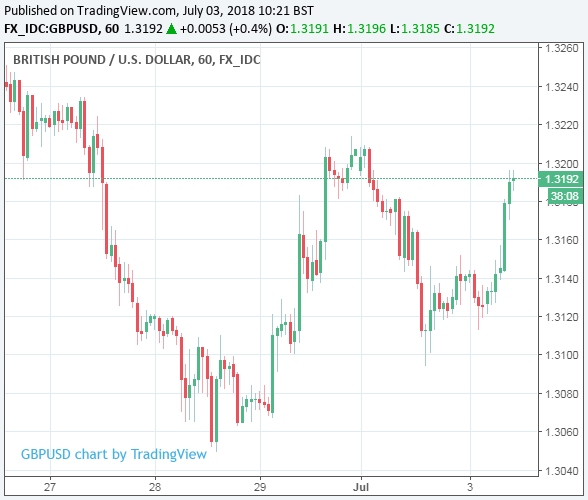Pound Sterling Advances on Dollar and Euro after Beleaguered Construction Sector Recovers in June
- Written by: James Skinner
-
-June UK Construction PMI beats expectations with rise to 53.1.
-Recovery in new orders supports growth in residential, commercial.
-But economists say its "too early" to expect sector to support growth.

© aallm, Adobe Stock
The Pound rose against the Dollar and Euro Tuesday after the latest IHS Markit PMI showed the UK's beleaguered construction industry turning a corner in June, with the index of activity in the sector rising at its fastest pace for eight months.
The IHS Markit Construction PMI rose to 53.1 in June, up from 52.5 in May, when economists had looked for the index to rise to just 52.6.
Both residential and commercial construction sectors saw a notable upturn in activity during June and the outlook for the months ahead also brightened too, with new orders rising at their fastest pace in more than a year while input buying increased at its fastest pace for two and a half years.
Job creation in the sector picked up during the month while companies responding to the IHS Markit survey reported faster input buying was the result of the increase in new work, as well as forward purchases designed to get around forthcoming materials price rises. Materials prices rose at their fastest pace for nine months in June.
Business optimism about the future also saw a recovery during the recent month, supported by an increase in infrastructure project work, which is flagged to be a key source of growth for the industry in the next 12 months.
"The pick-up in the construction PMI in June indicates that the sector no longer is in retreat, but the near-term outlook remains bleak. The average level of the PMI in Q2 is consistent on past form with output merely holding steady, having dropped by 0.8% quarter-on-quarter in Q1," says Samuel Tombs, chief UK economist at Pantheon Macroeconomics. "As a result, we think it’s still too soon to be looking for the construction sector to support GDP growth."

Above: Pound-to-Dollar rate shown at hourly intervals.
The Pound was quoted 0.37% higher at 1.3188 against the Dollar following the release while the Pound-to-Euro rate was 0.21% higher at 1.1311. Sterling was also higher against all other developed world currencies on the morning.

Above: Pound-to-Euro rate shown at hourly intervals.
PMI surveys measure changes in industry activity by asking respondents to rate conditions for employment, production, new orders, prices, deliveries and inventories. A number above the 50.0 level indicates industry expansion while a number below is consistent with contraction.
Markets care about the PMI data because, covering the UK's three largest commercial sectors, they are an important indicator of momentum within the economy. And economic growth has direct bearing on the rate of inflation and it is consumer price pressures that dicate where interest rates, which are the raison d'être for most moves in exchange rates, will go next.
The construction industry has been a drag on UK economic growth during the last year and, according to Office for National Statistics data released at the end of June, shrank by -0.8% during the first quarter. Previously the ONS said the industry contracted 2.7% but more complete data showed this to be an overstatement.
Nonetheless the slowdown in the industry, brought about by earlier weakness commercial construction activity, weighed on the broader economy at the start of the year when UK GDP growth slowed from 0.4% at the end of 2017 to just 0.2% for the three months to the end of March.
Advertisement
Get up to 5% more foreign exchange by using a specialist provider to get closer to the real market rate and avoid the gaping spreads charged by your bank when providing currency. Learn more here
Bank of England in Focus
The first-quarter economic slowdown, and a steep decline in UK inflation, led the Bank of England (BoE) to abandon the idea of an interest rate rise in May. This dented the Pound and left markets looking to the August meeting for the next possible move.
"I would have voted to raise Bank Rate at the MPC’s May meeting had data on the economy held firm. What we saw ahead of that meeting was a string of weak data suggesting consumer spending might be faltering," says Andy Haldane, chief economist at the BoE and a member of the Monetary Policy Committee (MPC), in a speech last week. "I believed there was option value in waiting to see if these data signalled the start of a lasting retrenchment by households, or were instead a temporary snow or statistical blip."
Haldane was one of three MPC members to have voted in June for an increase in the UK's main interest rate, after eschewing such a decision in May. Many economists now expect the Bank of England will go ahead and raise rates in August, although financial markets have been slow to take note.
Sterling-Overnight-Index-Average pricing on the morning of Thursday 28 June implied and August 02 Bank Rate of 0.59%. If markets were as confident in the likelihood of an August rate rise as Andy Haldane appears to be in the merits of one then that implied rate would be closer to the 0.75% the actual Bank Rate will sit at the next time the BoE pulls the trigger.
If and when financial markets become more willing to bet on an August interest rate rise then this implied rate will rise further, and the Pound with it.
Advertisement
Get up to 5% more foreign exchange by using a specialist provider to get closer to the real market rate and avoid the gaping spreads charged by your bank when providing currency. Learn more here




